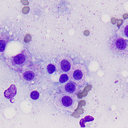Effects of inhibitors of vascular endothelial growth factor receptor 2 and downstream pathways of receptor tyrosine kinases involving phosphatidylinositol 3-kinase/Akt/mammalian target of rapamycin or mitogen-activated protein kinase in canine hemangiosarcoma cell lines.
Mots clés
Abstrait
Canine hemangiosarcoma (HSA) is a progressive malignant neoplasm with no current effective treatment. Previous studies showed that receptor tyrosine kinases and molecules within their downstream pathways involving phosphatidylinositol 3-kinase (PI3K)/Akt/mammalian target of rapamycin (m-TOR) or mitogen-activated protein kinase (MAPK) were overexpressed in canine, human, and murine tumors, including HSA. The present study investigated the effects of inhibitors of these pathways in canine splenic and hepatic HSA cell lines using assays of cell viability and apoptosis. Inhibitors of the MAPK pathway did not affect canine HSA cell viability. However, cell viability was significantly reduced by exposure to inhibitors of vascular endothelial growth factor receptor 2 and the PI3K/Akt/m-TOR pathway; these inhibitors also induced apoptosis in these cell lines. These results suggest that these inhibitors reduce the proliferation of canine HSA cells by inducing apoptosis. Further study of these inhibitors, using xenograft mouse models of canine HSA, are warranted to explore their potential for clinical application.



